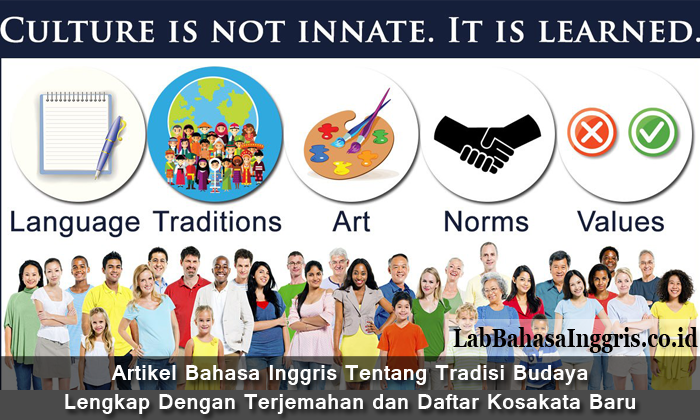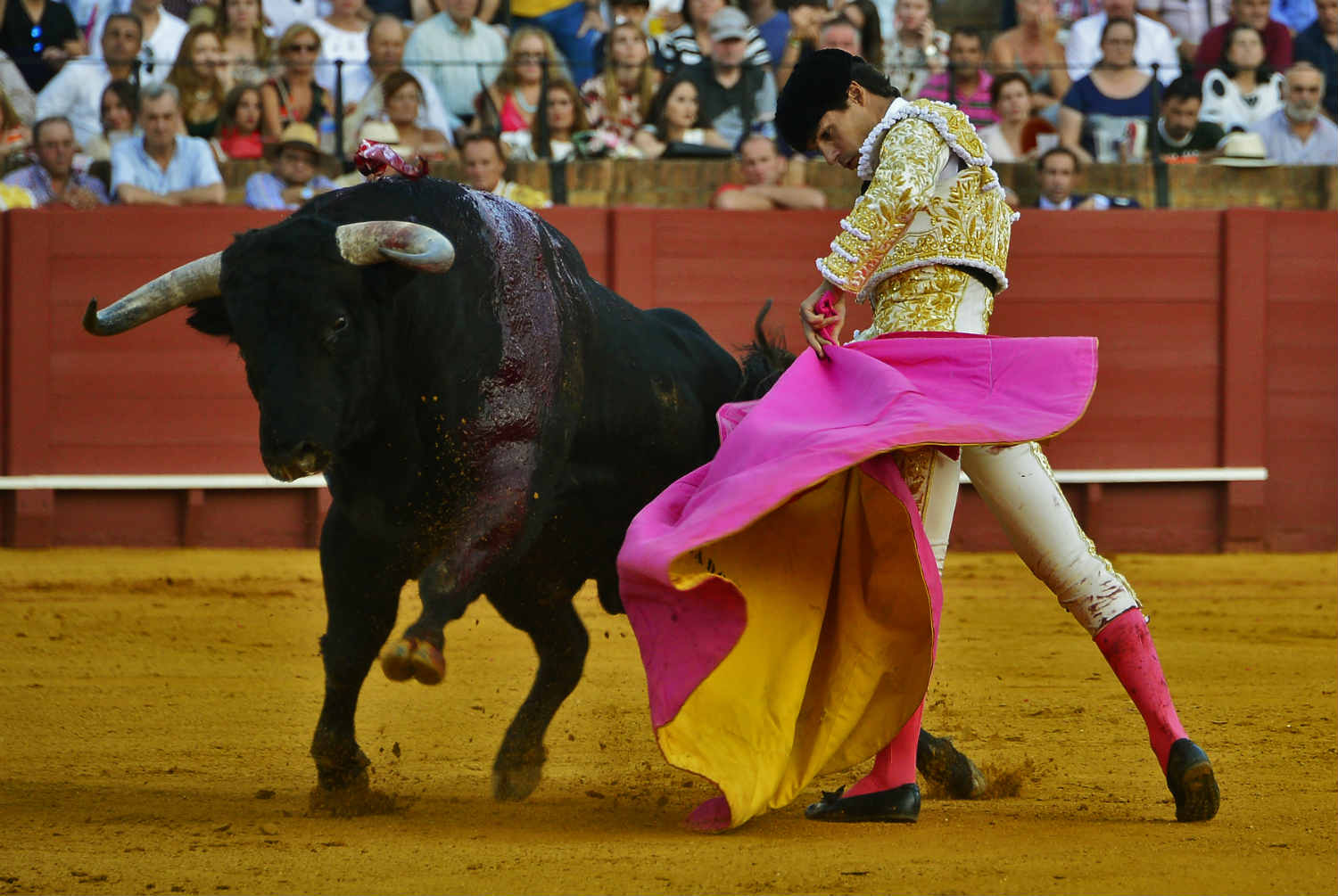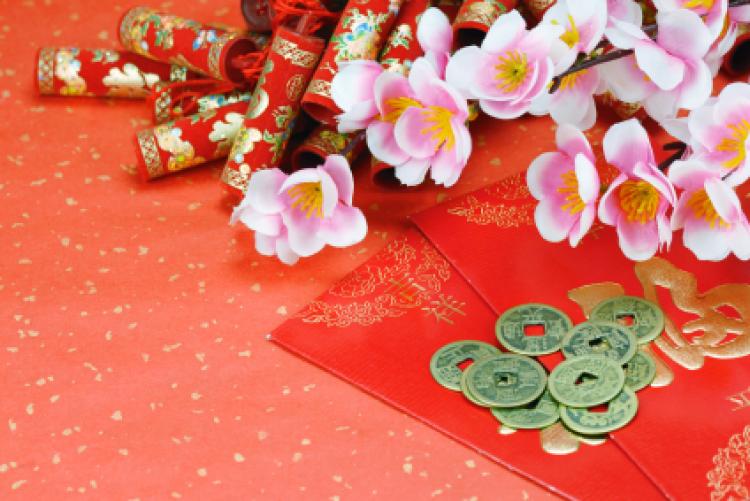LabBahasaInggris.co.id – Tradisi atau kebiasaan (Latin: traditio, “diteruskan”) adalah sesuatu yang telah dilakukan untuk sejak lama dan menjadi bagian dari kehidupan suatu kelompok masyarakat, biasanya dari suatu negara, kebudayaan, waktu, atau agama yang sama. Hal yang paling mendasar dari tradisi adalah adanya informasi yang diteruskan dari generasi ke generasi baik tertulis maupun (sering kali) lisan, karena tanpa adanya ini, suatu tradisi dapat punah. Budaya atau kebudayaan berasal dari bahasa Sanskerta yaitu buddhayah, yang merupakan bentuk jamak dari buddhi (budia atau akal) diartikan sebagai hal-hal yang berkaitan dengan budi, dan akal manusia.
Artikel hari ini saya akan memberikan beberapa informasi tentang Tradisi dan Budaya dalam bentuk teks bahasa Inggris pendek.
Yuk, kita simak bersama…
Table of Contents
Artikel Bahasa Inggris Tentang Tradisi Budaya Lengkap Dengan Terjemahan dan Daftar Kosakata Baru

Artikel Bahasa Inggris Tentang Tradisi Budaya
Jeans – History and Popularity of Great Clothes
Jeans have become one of the most worn pieces of clothing in the world. Everybody wears them, from the rural farmer to the urban lawyer and from models to housewives. But why have jeans become so popular? You’ll get many answers. For some people they look cool, for others, jeans are simply comfortable.
Jeans were first designed as durable trousers for farm workers and miners in the states of the American West. A Nevada tailor, Jacob Davis, had the idea of using copper bolts at the corner of the pockets to make them stronger. They became popular instantly and soon many people bought them.
Although Davis knew that he had a great product which many people wanted to buy, he didn’t have the money to patent it. He asked Levi Strauss, who supplied him with cloth, to help him out. The two worked together and started making jeans out of denim, which was more comfortable and could be easily stretched. It also became softer as it got older. They were dyed with indigo because it did not go through the cloth as other dyes do.
At first, jeans were worn only by workers, especially in factories. In the eastern part of the US, jeans were hardly worn at all. They were associated with rural people and the working class. But when rich easterners went on holidays to escape everyday life they often put on jeans.

James Dean and Marlon Brando made them popular in movies and everyone wanted to wear them. Jeans became a symbol of the youth rebellion during the 1950s and 1960s. College students started to wear them as a protest against the Vietnam War and the establishment. The new trousers were banned in American schools and sometimes in theatres and cinemas. As time went on jeans became more acceptable and today they are worn not only as casual clothes but also at formal events.
Other countries quickly started to get accustomed to wearing jeans too. American servicemen on duty in Europe and Japan often wore them when they were not on duty to show that they were Americans. The trousers showed the world a happier way of life, something that people needed, especially after what they had endured in World War II.
Jeans were also worn because they made people equal. You could afford them and they couldn’t be torn so easily. They had practical advantages as well. They didn’t need to be washed as often as other trousers and women didn’t need to iron them. This became more important as more and more women started working and had less time for housework.
Today jeans are an essential part of our lives. They are almost always washed a few times before being sold to give them their faded appearance.
Vocabularies
- acceptable = good enough, all right
- accustomed = to get used to
- advantage = good side
- afford = to have enough money to buy something
- although = while
- appearance = how something looks
- associate = connect, link
- ban = forbid
- bolt = a metal piece used to hold things together
- casual = relaxed
- cloth = material used for making clothes
- clothing = clothes, outfit
- copper = soft reddish-brown metal
- denim = strong cotton cloth
- durable = strong; hard-wearing
- dye = color
- endure = to go through
- equal = the same
- escape = get away from
- especially = above all
- essential = very important
- establishment = group of people who have a lot of power in a country
- fade = lose color
- formal = official
- hardly = not very much
- indigo = dark blue color
- instantly = at once
- iron = to make clothes smooth and flat
- lawyer = a person who has studied law
- miner = a person who works mostly underground and digs minerals out of the earth
- on duty = to work
- patent = to get the rights to produce something
- popular = liked by many
- practical = useful
- rural = countryside
- serviceman = member of the army
- stretch = to make flexible
- supply = sell
- tailor = someone who makes clothes
- tear – tore- torn = break
- urban = from the city
Terjemahan
Jeans – Sejarah dan Popularitas Pakaian Luar Biasa
Jeans telah menjadi salah satu pakaian yang paling sering dipakai di dunia. Semua orang memakainya, dari petani pedesaan ke pengacara kota dan dari model ke ibu rumah tangga. Tetapi mengapa jeans menjadi begitu populer? Anda akan mendapatkan banyak jawaban. Bagi sebagian orang mereka terlihat keren, bagi yang lain, celana jins cukup nyaman.
Jeans pertama kali dirancang sebagai celana tahan lama untuk pekerja pertanian dan penambang di negara bagian Amerika Barat. Penjahit Nevada, Jacob Davis, memiliki ide untuk menggunakan baut tembaga di sudut kantong untuk membuatnya lebih kuat. Mereka menjadi populer secara instan dan segera banyak orang membelinya.
Meskipun Davis tahu bahwa dia memiliki produk hebat yang ingin dibeli banyak orang, dia tidak punya uang untuk mematenkannya. Dia meminta Levi Strauss, yang menyediakannya dengan kain, untuk membantunya. Keduanya bekerja bersama dan mulai membuat jeans dari denim, yang lebih nyaman dan bisa dengan mudah diregangkan. Itu juga menjadi lebih lembut seiring bertambahnya usia. Mereka diwarnai dengan indigo karena tidak menembus kain seperti pewarna lainnya.
Awalnya, jeans hanya dikenakan oleh pekerja, terutama di pabrik. Di bagian timur AS, celana jins hampir tidak dipakai sama sekali. Mereka dikaitkan dengan orang-orang pedesaan dan kelas pekerja. Tetapi ketika orang-orang timur yang kaya pergi berlibur untuk melarikan diri dari kehidupan sehari-hari, mereka sering mengenakan celana jins.
James Dean dan Marlon Brando menjadikannya populer di film dan semua orang ingin memakainya. Jeans menjadi simbol pemberontakan pemuda selama tahun 1950-an dan 1960-an. Mahasiswa mulai memakainya sebagai protes terhadap Perang Vietnam dan kemapanan. Celana panjang baru itu dilarang di sekolah-sekolah Amerika dan terkadang di teater dan bioskop. Seiring berjalannya waktu jeans menjadi lebih dapat diterima dan hari ini mereka dikenakan tidak hanya sebagai pakaian kasual tetapi juga di acara-acara formal.
Negara-negara lain dengan cepat mulai terbiasa mengenakan jeans juga. Prajurit Amerika yang bertugas di Eropa dan Jepang sering mengenakannya ketika mereka tidak bertugas untuk menunjukkan bahwa mereka adalah orang Amerika. Celana panjang itu menunjukkan kepada dunia cara hidup yang lebih bahagia, sesuatu yang dibutuhkan orang, terutama setelah apa yang mereka alami dalam Perang Dunia II.
Jeans juga dipakai karena mereka membuat orang sama. Anda bisa membelinya dan mereka tidak bisa robek dengan mudah. Mereka juga memiliki keunggulan praktis. Mereka tidak perlu dicuci sesering celana lainnya dan wanita tidak perlu menyetrika mereka. Ini menjadi lebih penting karena semakin banyak perempuan mulai bekerja dan memiliki lebih sedikit waktu untuk pekerjaan rumah.
Jeans saat ini adalah bagian penting dari kehidupan kita. Mereka hampir selalu dicuci beberapa kali sebelum dijual untuk memberikan penampilan pudar.
[su_box title=”Read More” style=”default” box_color=”#333333″ title_color=”#FFFFFF” radius=”3″ class=””]Artikel Bahasa Inggris Tentang Ekonomi Bisnis Lengkap Dengan Terjemahan dan Daftar Kosakata Baru[/su_box]
Bullfighting – A Big Attraction in Spain
Bullfighting is a great event that attracts many tourists to Spain and Spanish speaking countries. There it is an important element of culture and has a great tradition. Modern bullfighting goes back to the 1700s when the first bullrings were built in Spain.
A bullfight takes place in a bullring. The Matador, or bullfighter, has special training and is often a national hero in his homeland. The bulls used for bullfighting are very powerful, wild animals that are bred to attack. They weigh up to 500 kg or even more. Today many animal activists are against bullfighting because bulls are treated in a cruel way and have to suffer pain in the arena. Bullfights can also end with a matador’s death or injury if he is pierced by a bull’s horns.

A bullfight usually consists of six fights. Three matadors with their teams fight two bulls each. A bullfight has three acts. After the trumpets sound at the beginning, the bull is let into the ring. The bullfighter waves a colourful cape at the bull and tries to make it attack. During this part, he studies the movements of the bull. A picador enters the arena on horseback. He makes the bull weaker by piercing his neck with sharp spikes.
In the second act, the assistance of the matador, called banderilleros, come into the ring on foot, run around and throw barbed darts into the animal’s neck to make it even madder.
In the final act, the bullfighter is in the ring alone with the bull. He uses a small cape, waves at the bull and lures it into attacking him. He tries to be as close to the bull as possible. Finally, he thrusts his sword into the bull’s neck and kills it. If he succeeds in pushing the sword into the bull’s shoulder blades it dies at once. After the successful performance of the matador, the spectators get up and applaud. The bullfighter gets one or maybe even two of the bull’s ears as a reward.
Vocabularies
- attack = to hit someone in a violent way
- attract = to pull towards; bring to
- barbed = with one or more curved points
- breed – bred = to bring animals together so that they can have babies that are very good or strong
- cape = a piece of cloth that a bullfighter waves
- close = near
- consist of = is made up of
- cruel = brutal
- injury = to damage a part of your body
- lure = to make someone do something you want
- madder = angrier
- movement = how it moves from one place to another
- performance = act, show
- picador = man in a bullfight who rides a horse and weakens a bull by throwing small spears into it
- pierce = to make a small hole into something with a sharp object
- reward = prize
- shoulder blade = one of the two flat bones on each side of your back
- spectator = a person who watches a fight
- spike = sharp, metal points
- succeed = to do well
- suffer = undergo
- sword = a weapon with a long pointed blade
- thrust = push, force
- weigh = how heavy something is
Terjemahan
Adu Banteng – Daya Tarik Besar di Spanyol
Adu banteng adalah acara hebat yang menarik banyak wisatawan ke Spanyol dan negara-negara berbahasa Spanyol. Itu adalah elemen budaya yang penting dan memiliki tradisi yang hebat. Perkelahian manusia melawan banteng modern kembali ke tahun 1700-an ketika banteng pertama dibangun di Spanyol.
Adu banteng terjadi di arena adu banteng. Matador, atau matador, memiliki pelatihan khusus dan sering menjadi pahlawan nasional di tanah kelahirannya. Sapi jantan yang digunakan untuk adu banteng adalah hewan liar yang sangat kuat, yang dibiakkan untuk menyerang. Beratnya hingga 500 kg atau bahkan lebih. Saat ini banyak aktivis hewan menentang perkelahian manusia melawan banteng karena banteng diperlakukan dengan cara yang kejam dan harus menderita sakit di arena. Adu banteng juga bisa berakhir dengan matador kematian atau cedera jika dia ditusuk oleh tanduk banteng.
Adu banteng biasanya terdiri dari enam pertarungan. Tiga matador dengan tim mereka masing-masing bertarung dua ekor. Adu banteng memiliki tiga babak. Setelah terompet berbunyi di awal, banteng dibiarkan masuk ke dalam ring. Bullfighter mengayunkan jubah berwarna-warni ke arah banteng dan mencoba membuatnya menyerang. Selama bagian ini, ia mempelajari pergerakan banteng. Seorang picador memasuki arena dengan menunggang kuda. Dia membuat lembu jantan lebih lemah dengan menusuk lehernya dengan paku yang tajam.
Pada babak kedua, bantuan matador, yang disebut banderilleros, datang ke ring dengan berjalan kaki, berlari-lari dan melemparkan anak panah berduri ke leher hewan untuk membuatnya lebih marah lagi.
Pada babak final, matador ada di atas ring sendirian bersama banteng. Dia menggunakan jubah kecil, melambaikan tangan pada banteng dan membujuknya untuk menyerangnya. Dia berusaha sedekat mungkin dengan banteng. Akhirnya, dia menusukkan pedangnya ke leher banteng dan membunuhnya. Jika dia berhasil mendorong pedang ke pundak banteng itu mati sekaligus. Setelah pertunjukan matador sukses, para penonton bangkit dan bertepuk tangan. Petarung banteng mendapat satu atau bahkan dua telinga banteng sebagai hadiah.
[su_box title=”Read More” style=”default” box_color=”#333333″ title_color=”#FFFFFF” radius=”3″ class=””]Teks Bahasa Inggris Tentang KESEHATAN Lengkap Dengan Terjemahan dan Daftar Kosakata Baru[/su_box]
Chinese New Year
Chinese New Year is the most important holiday of the Chinese calendar. The New Year begins between January 21 and February 20. The celebration starts with the second new moon after the beginning of winter (December 21) and lasts until the next full moon.
The Chinese name their years after 12 different animals: the rat, the ox, the tiger, the hare, the dragon, the snake, the horse, the sheep, the monkey, the rooster, the dog, the pig. Some people believe that a human being’s personality and character depends on the animal of the year he or she was born.
The Chinese New Year marks the start of the next animal’s year. After the year of the pig, the twelve-year cycle starts over again with the year of the rat.
A lot of things are done for Chinese New Year. Houses are cleaned from top to bottom in the days before the beginning of the holidays. People write merry wishes on red paper and hang them all over the house. Rooms are decorated with flowers, plants, and oranges.
On New Year’s Eve firecrackers send out the old year and welcome the new one. At midnight people open all their doors and windows to let the old year out. On New Year’s Day children and adults who are not married get red envelopes with money in them. This is a symbol of good look and wealth in the new year.

Food plays an important part in Chinese New Year celebrations. Special dishes are eaten on certain days. Many kinds of food have special meanings. Uncut noodles, for example, might give you a longer life. People who eat a lot of raw fish are said to be more successful in life.
The last event of the 15-day celebration is the Lantern Festival. Some people hang glowing lanterns in temples. Others carry lanterns in a moonlight parade. In many places, long colourful dragons made out of silk, paper, and bamboo are carried on the streets by dancers.
Vocabularies
- admire = to respect and think highly of
- bamboo = a tropical plant that is empty inside; it is used to make furniture
- celebration = event of celebrating, having a party
- cycle = a series of events that happen again and again, mostly in the same order
- decorate = to make something look more beautiful by putting nice things on it
- depend on =here: something affects something else
- dish = meal
- dragon = a large animal that has wings and can breathe out the fire
- envelope = a thin paper in which you put and send a letter
- firecracker = a small firework that explodes loudly
- glow = to produce or reflect light
- hare = rabbit
- human being = a person
- lantern = a lamp that has a light inside it
- mark =is the sign for
- merry = happy, cheerful
- noodles =long pieces of thin food made from flour water and eggs, like spaghetti
- personality = someone’s character; the way they behave towards others
- raw = not cooked
- rooster = a male chicken
- silk = a smooth soft cloth made from a material that is produced by a silkworm
- temple = a place where people go to pray to God
- uncut = not cut
- wealth = a lot of money; being rich
Terjemahan
Tahun Baru Imlek
Tahun Baru Cina adalah hari libur terpenting dari kalender Cina. Tahun Baru dimulai antara 21 Januari dan 20 Februari. Perayaan dimulai dengan bulan baru kedua setelah awal musim dingin (21 Desember) dan berlangsung hingga bulan purnama berikutnya.
Orang Cina menamai tahun-tahun mereka setelah 12 binatang yang berbeda: tikus, lembu, harimau, kelinci, naga, ular, kuda, domba, monyet, ayam jago, anjing, babi. Beberapa orang percaya bahwa kepribadian dan karakter manusia bergantung pada binatang tahun ia dilahirkan.
Tahun Baru Cina menandai awal tahun hewan berikutnya. Setelah tahun babi, siklus dua belas tahun dimulai lagi dengan tahun tikus.
Banyak hal yang dilakukan untuk Tahun Baru Imlek. Rumah-rumah dibersihkan dari atas ke bawah pada hari-hari sebelum awal liburan. Orang-orang menulis permohonan selamat di kertas merah dan menggantungnya di seluruh rumah. Kamar-kamarnya didekorasi dengan bunga, tanaman, dan jeruk.
Pada malam Tahun Baru petasan mengirimkan tahun yang lama dan menyambut yang baru. Pada tengah malam orang membuka semua pintu dan jendela mereka untuk membiarkan tahun tua keluar. Pada Hari Tahun Baru anak-anak dan orang dewasa yang belum menikah mendapatkan amplop merah dengan uang di dalamnya. Ini adalah simbol ketampanan dan kekayaan di tahun baru.
Makanan memainkan peranan penting dalam perayaan Tahun Baru Cina. Hidangan spesial dimakan pada hari-hari tertentu. Banyak jenis makanan memiliki arti khusus. Mie yang belum dipotong, misalnya, mungkin memberi Anda umur yang lebih panjang. Orang yang makan banyak ikan mentah dikatakan lebih sukses dalam hidup.
Acara terakhir dari perayaan 15 hari adalah Festival Lentera. Beberapa orang menggantung lentera menyala di kuil. Yang lain membawa lentera dalam parade cahaya bulan. Di banyak tempat, naga panjang berwarna-warni yang terbuat dari sutra, kertas, dan bambu dibawa di jalanan oleh para penari.
[su_box title=”Read More” style=”default” box_color=”#333333″ title_color=”#FFFFFF” radius=”3″ class=””]Artikel Bahasa Inggris Tentang PENDIDIKAN Lengkap Dengan Terjemahan dan Daftar Kosakata Baru[/su_box]
Demikian beberapa contoh Teks Bahasa Inggris tentang Tradisi Dan Budaya. Semangat belajar!